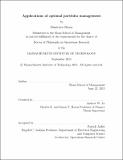Applications of optimal portfolio management
Author(s)
Bisias, Dimitrios
DownloadFull printable version (2.338Mb)
Other Contributors
Massachusetts Institute of Technology. Operations Research Center.
Advisor
Andrew W. Lo.
Terms of use
Metadata
Show full item recordAbstract
This thesis revolves around applications of optimal portfolio theory. In the first essay, we study the optimal portfolio allocation among convergence trades and mean reversion trading strategies for a risk averse investor who faces Value-at-Risk and collateral constraints with and without fear of model misspecification. We investigate the properties of the optimal trading strategy, when the investor fully trusts his model dynamics. Subsequently, we investigate how the optimal trading strategy of the investor changes when he mistrusts the model. In particular, we assume that the investor believes that the data will come from an unknown member of a set of unspecified alternative models near his approximating model. The investor believes that his model is a pretty good approximation in the sense that the relative entropy of the alternative models with respect to his nominal model is small. Concern about model misspecification leads the investor to choose a robust optimal portfolio allocation that works well over that set of alternative models. In the second essay, we study how portfolio theory can be used as a framework for making biomedical funding allocation decisions focusing on the National Institutes of Health (NIH). Prioritizing research efforts is analogous to managing an investment portfolio. In both cases, there are competing opportunities to invest limited resources, and expected returns, risk, correlations, and the cost of lost opportunities are important factors in determining the return of those investments. Can we apply portfolio theory as a systematic framework of making biomedical funding allocation decisions? Does NIH manage its research risk in an efficient way? What are the challenges and limitations of portfolio theory as a way of making biomedical funding allocation decisions? Finally in the third essay, we investigate how risk constraints in portfolio optimization and fear of model misspecification affect the statistical properties of the market returns. Risk sensitive regulation has become the cornerstone of international financial regulations. How does this kind of regulation affect the statistical properties of the financial market? Does it affect the risk premium of the market? What about the volatility or the liquidity of the market?
Description
Thesis: Ph. D., Massachusetts Institute of Technology, Sloan School of Management, Operations Research Center, 2015. This electronic version was submitted by the student author. The certified thesis is available in the Institute Archives and Special Collections. Cataloged from student-submitted PDF version of thesis. Includes bibliographical references (pages 183-188).
Date issued
2015Department
Massachusetts Institute of Technology. Operations Research Center; Sloan School of ManagementPublisher
Massachusetts Institute of Technology
Keywords
Operations Research Center.